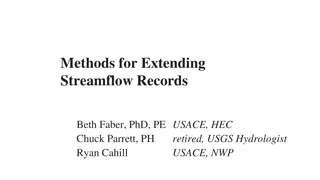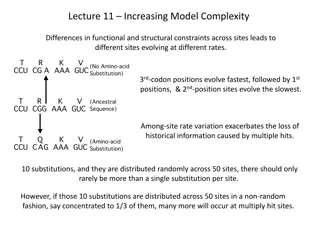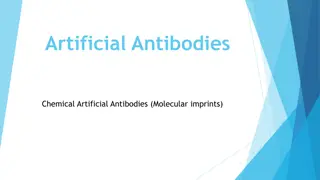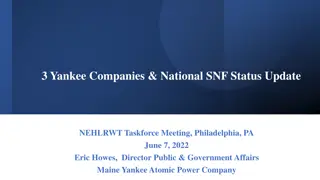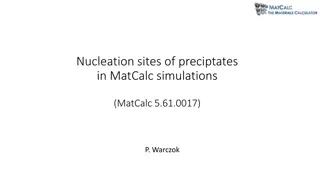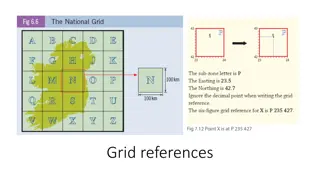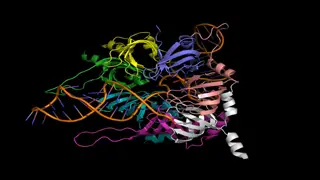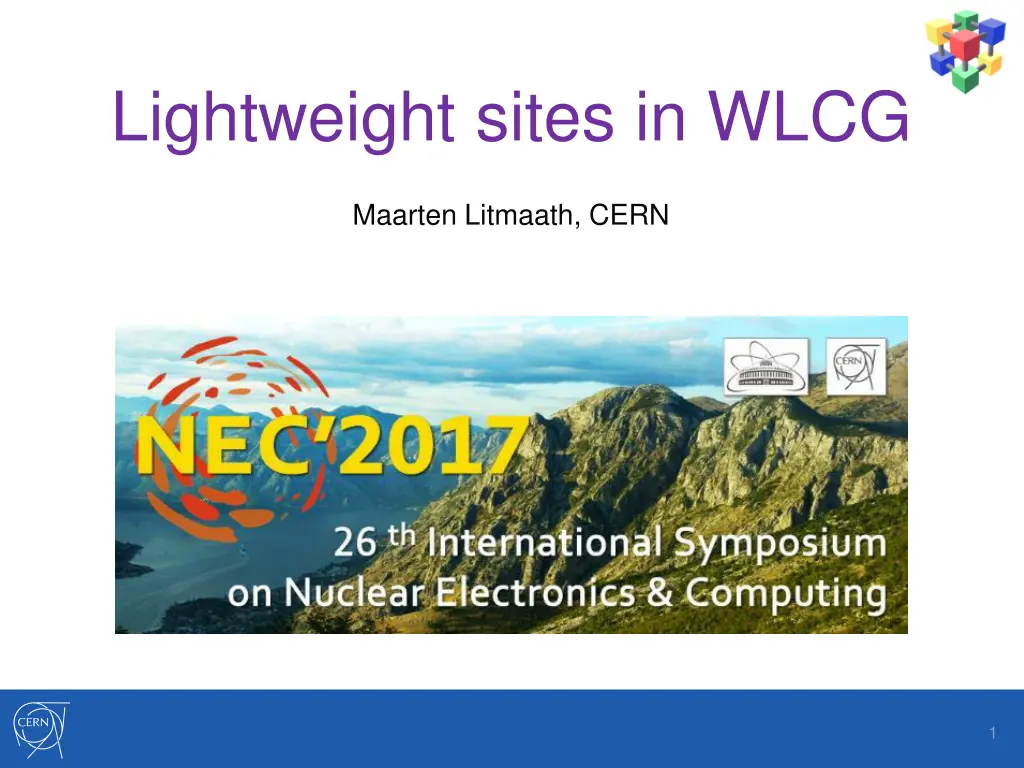
Simplifying Computing Resources in WLCG
Explore how the WLCG aims to simplify operations for smaller sites to contribute effectively, focusing on computing resources, data access boundaries, EGI and OSG distinctions, and differences between T2 and T3 sites.
Download Presentation

Please find below an Image/Link to download the presentation.
The content on the website is provided AS IS for your information and personal use only. It may not be sold, licensed, or shared on other websites without obtaining consent from the author. If you encounter any issues during the download, it is possible that the publisher has removed the file from their server.
You are allowed to download the files provided on this website for personal or commercial use, subject to the condition that they are used lawfully. All files are the property of their respective owners.
The content on the website is provided AS IS for your information and personal use only. It may not be sold, licensed, or shared on other websites without obtaining consent from the author.
E N D
Presentation Transcript
Lightweight sites in WLCG Maarten Litmaath, CERN 1
Rationale One of the goals of WLCG Operations Coordination activities is to help simplify what the majority of the sites, i.e. the smaller ones, need to do to be able to contribute resources in a useful manner, i.e. with large benefits compared to efforts invested. Classic grid sites may profit from simpler mechanisms to deploy and manage services. Moreover, we may be able to get rid of some service types in the end. New and existing sites may rather want to go into one of the cloud directions that we will collect and document. There may be different options also depending on the experiment(s) that the site supports. There is no one-size-fits-all solution. We will rather have a matrix of possible approaches, allowing any site to check which ones could work in its situation, and then pick the best. 2
Boundaries storage & data access Under the aegis of the WLCG Data Steering Group Data federations Multi-site storage Caches Diskless sites Big data technologies Potential for paradigm changes A number of these areas will be covered by other presentations in today s session Further information WLCG workshop June 2017 Data session May 2017 GDB Here we focus on computing resources instead 3
Boundaries EGI and OSG In OSG every WLCG site mainly supports just a single LHC experiment The sites are managed in close collaboration with the US project in each experiment US-ATLAS, US-CMS, US-ALICE Both US-ATLAS and US-CMS have already been working on lighter ways to provision their resources Ubiquitous Cyberinfrastructure, Virtual Clusters Tier-3 in a box, Pacific Research Platform In EGI the situation is a lot more complex Multi-experiment sites, many countries/cultures/projects/ , more MW diversity, experiments have less influence, Here we should focus on the EGI sites then While learning from the OSG sites 4
T2 vs. T3 sites T3 sites have not signed the WLCG MoU Typically dedicated to a single experiment can take advantage of shortcuts T2 sites have rules that apply Availability / Reliability targets Accounting into EGI / OSG / WLCG repository EGI: presence in the info system for the Ops VO Security regulations Mandatory OS and MW updates and upgrades Isolation Traceability Security tests and challenges Evolution is possible Some rules could be adjusted The infrastructure machinery can evolve 5
How to enable computing Services that currently are or may be needed to enable computing at a grid site: Computing Element Batch system Cloud setups Authorization system Info system Accounting CVMFS Squid Monitoring 6
How to enable computing Reduce the catalog of required services, where possible? Replace classic, complex portfolio with alternative, more widespread technologies? Simplify deployment, maintenance and operation of what needs to remain? 7
Less diversity would help Batch systems on the rise HTCondor Slurm CE implementations on the rise HTCondor ARC Configuration systems on the rise Puppet Ansible 8
Tap into popular technologies? Cloud systems on the rise OpenStack Container systems on the rise Docker Singularity Kubernetes Mesos OpenStack Magnum OpenShift ... Many winners for now? 9
Lightweight sites classic view How to provide resources with less effort? Keep things basically the same, but easier Site responses to a questionnaire show the potential benefits of shared repositories OpenStack images Pre-built services, pre-configured where possible Docker containers Ditto Puppet modules For site-specific configuration 10
Lightweight sites alternative view CE + batch system not strictly needed Cloud VMs or containers could be sufficient They can be managed e.g. with Vac or Vcycle Several GridPP sites are doing that already All 4 experiments are covered The resources are properly accounted They can directly receive work from an experiment s central task queue Or they can rather join a regional or global HTCondor pool to which an experiment submits work Proof of concept used by GridPP sites for ALICE Cf. the CMS global GlideinWMS pool scalable to O(100k) 11
Distributed site operations model A site needs to provide resources at an agreed QoS level HW needs to be administered by the site Other admin operations could be done by a remote, possibly distributed team of experts Site resources within a region could be integrated into a regional cloud Example: JINR cloud extending to partner sites Or they could be integrated by a regional virtual HTCondor batch system VMs/containers of willing sites may join the pool directly CEs and batch systems of other sites can be addressed through Condor-G The virtual site exposes an HTCondor CE interface through which customers submit jobs to the region HTCondor then routes the jobs according to fair-share etc. 12
Volunteer computing The LHC@home project coordinates volunteer computing activities across the experiments ATLAS have benefited from 1-2% extra resources for simulation workloads See this recent talk by David Cameron It could become a way for a computing-only lightweight site to provide its resources The central infrastructure can scale at least for simulation jobs The resources can be properly accounted in APEL 13
and lightweight sites Real sites can be trusted No need for volunteer CA or data bridge A separate, easier infrastructure would be set up BOINC can even coexist with a batch system on the same WN Successfully demonstrated at IHEP, Beijing Also here HTCondor is used under the hood Standard for experiments and service managers 14
Volunteer potential 400k 300k SixTrack 200k 100k 8th BOINC Pentathlon 2017 17
Computing resource SLAs The resources themselves can also be lightweight Please see this recent talk by Gavin McCance Extra computing resources could be made available at a lower QoS than usual Disk server CPU cycles, spot market, HPC backfill, intervention draining, Jobs might e.g. get lower IOPS and would typically be pre-emptible Machine-Job Features (MJF) functionality can help smooth the use They would have an SLA between those of standard and volunteer resources a mid-SLA 18
Lightweight operations We would like to have sites which can run almost by themselves With minimal oversight and operational efforts from people at the site Could we make use of Machine Learning algorithms to improve our monitoring? Automatic classification and filtering of log messages Definition of metrics that characterize the state of operations Early identification of remarkable trends 19
Conclusions and outlook Many small sites currently need to invest efforts that are not commensurate with their size nor available funding Multiple areas are being investigated to allow small sites to become more lightweight Sites are envisaged to be able to pick the best choice from a matrix of solutions WLCG thus may evolve toward increased flexibility and sustainability ! 20




